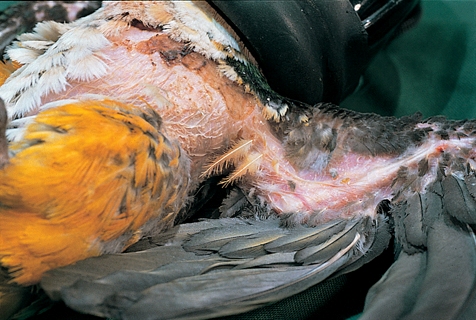Avian Medicine Q&A 20
Jump to navigation
Jump to search

| This question was provided by Manson Publishing as part of the OVAL Project. See more Avian Medicine questions |
This bird has been feather plucking.
| Question | Answer | Article | |
| List those medical causes of feather plucking which are or may be infectious, contagious or transmissible. | PBFD (circovirus); budgerigar fledgeling disease (Polyomavirus: French moult); ectoparasites (e.g. Dermanyssus gallinae); endoparasites (e.g. Giardia sp.); chlamydiosis; fungal dermatitis.
|
[[|Link to Article]] | |
| List the non-infectious medical, including metabolic, causes of feather plucking. | Bacterial dermatitis; pulpitis or folliculitis; allergy; hepatitis; hypothyroidism; skin neoplasia; follicular cysts; post-traumatic injury, or arthritic or scar tissue pain; nutritional deficiency (e.g. hypovitaminosis A; B vitamin deficiencies; essential amino acid deficiencies (e.g. lysine)).
|
[[|Link to Article]] | |
| Describe the diagnosis of the aetiologies described in q1. | PCR for PBFD and BFD; physical examination at day and night for ectoparasites; faecal examination for endoparasites; PCR/ELISA (antigen/antibody) for chlamydiosis; skin scrape microscopic examination and culture for fungal dermatitis; stained impression smear, culture and sensitivity for bacterial infections. Also, haematology
and biochemistry, thyroid stimulation test, biopsy and histopathology, improved diet and monitoring response to therapy. |
[[|Link to Article]] | |
| List the environmental causes of feather plucking. | Excess tobacco smoke; excessively dry atmosphere; excessive day length in direct sunlight; lack of environmental enrichment.
|
[[|Link to Article]] | |
| List the psychological causes of feather plucking. | Attention seeking; boredom; overcrowding; environmental change or lack of routine; sexual frustration; excessive preening; post untidy feather or wing clipping.
|
[[|Link to Article]] | |
